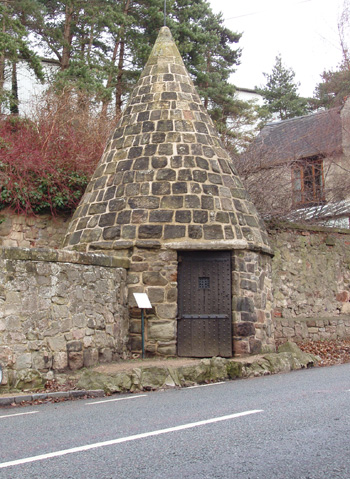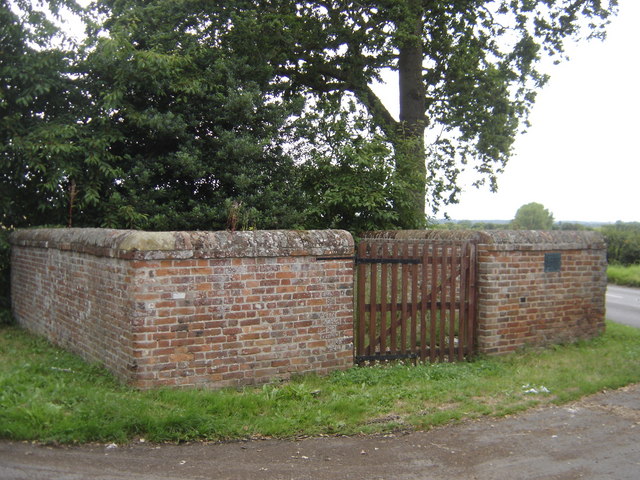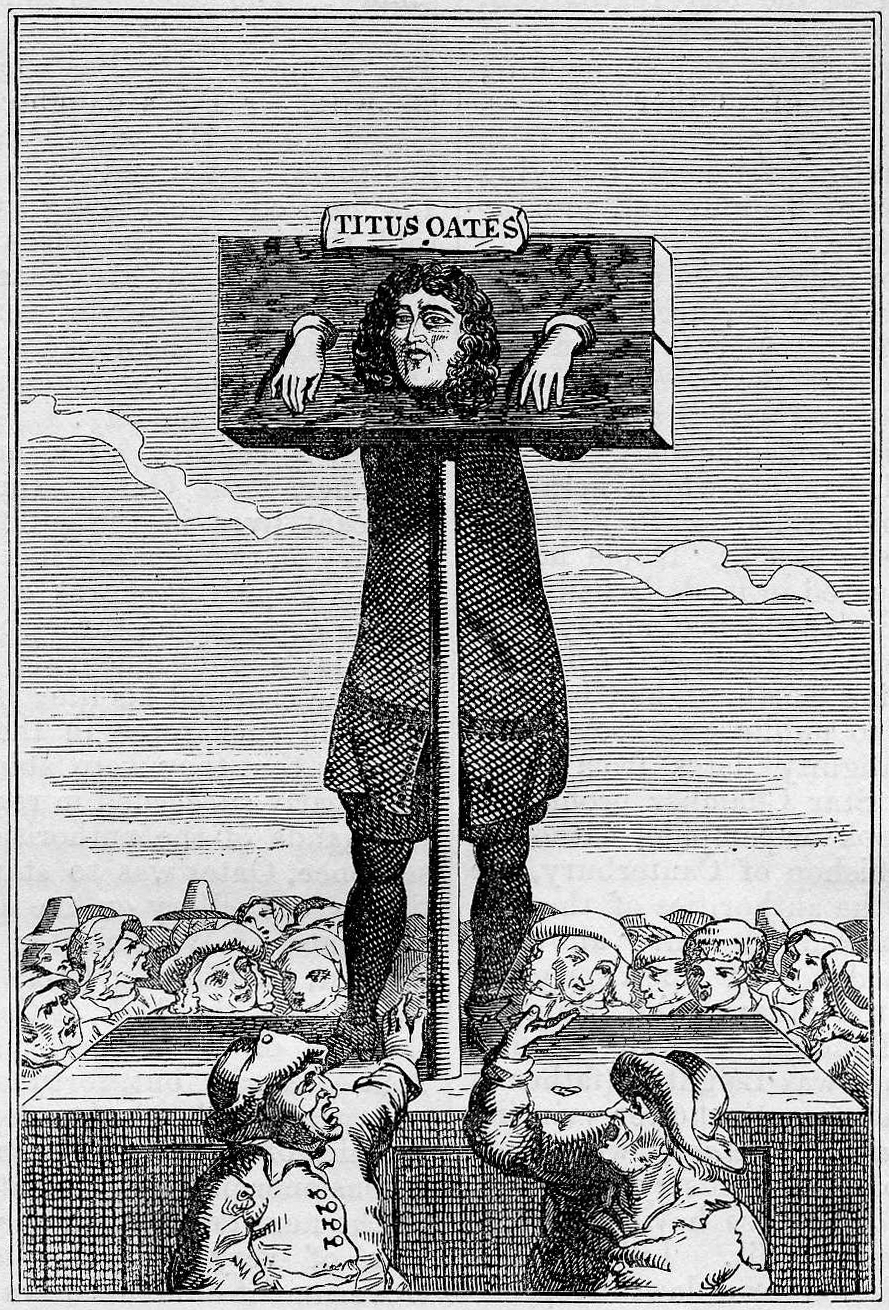|
Village Lock-up
A village lock-up is a historic building once used for the temporary detention of people in England and Wales, mostly where official prisons or criminal courts were beyond easy walking distance. Lockups were often used for the confinement of drunks, who were usually released the next day, or to hold people being brought before the local magistrate. The archetypal form comprises a small room with a single door and a narrow slit window, grating or holes. Most lock-ups feature a tiled or stone-built dome or spire as a roof and are built from brick, stone and/or timber. Such a room was built in many shapes; many are round, which gives rise to a sub-description: the punishment or village round-house (). Village lock-ups, though usually freestanding, were often attached to walls, tall pillar/tower village crosses or incorporated into other buildings. Varying in architectural strength and ornamentation, they were all built to perform the same function. Nicknames and forms They have a ... [...More Info...] [...Related Items...] OR: [Wikipedia] [Google] [Baidu] |
Barnaby Rudge
''Barnaby Rudge: A Tale of the Riots of Eighty'' (commonly known as ''Barnaby Rudge'') is a historical novel by English novelist Charles Dickens. ''Barnaby Rudge'' was one of two novels (the other was ''The Old Curiosity Shop'') that Dickens published in his short-lived (1840–1841) weekly serial ''Master Humphrey's Clock''. ''Barnaby Rudge'' is largely set during the Gordon Riots of 1780. ''Barnaby Rudge'' was the fifth of Dickens's novels to be published. It had initially been planned to appear as his first, but changes of publisher led to many delays, and it first appeared in serial form in the ''Clock'' from February to November 1841. It was Dickens's first historical novel. His only other is ''A Tale of Two Cities'' (1859), also set in revolutionary times. ''Barnaby Rudge'' is one of his less popular novels; British historian and Dickens biographer Peter Ackroyd has called it "one of Dickens's most neglected, but most rewarding, novels". It has rarely been adapted for fi ... [...More Info...] [...Related Items...] OR: [Wikipedia] [Google] [Baidu] |
Home Guard (United Kingdom)
The Home Guard (initially Local Defence Volunteers or LDV) was an unpaid armed citizen militia supporting the 'Home Forces' of the British Army during the Second World War. Operational from 1940 to 1944, the Home guard, Home Guard comprised more than 1.5 million local volunteers otherwise ineligible for military service, such as those who were too young, too old or medically unfit to join the regular British Armed Forces, armed services (regular military service was restricted to those aged 18 to 41) and those in reserved occupations. Excluding those already in the armed services, the civilian police or other civil defence volunteer organisations, approximately one in five men were Home Guard volunteers. Their primary role was to act as a secondary defence force in their home locality in case of Operation Sea Lion, invasion by the forces of Nazi Germany. The Home Guard were initially ordered to observe, and report back to General Headquarters Home Forces, any airborne or seabor ... [...More Info...] [...Related Items...] OR: [Wikipedia] [Google] [Baidu] |
World War II
World War II or the Second World War (1 September 1939 – 2 September 1945) was a World war, global conflict between two coalitions: the Allies of World War II, Allies and the Axis powers. World War II by country, Nearly all of the world's countries participated, with many nations mobilising all resources in pursuit of total war. Tanks in World War II, Tanks and Air warfare of World War II, aircraft played major roles, enabling the strategic bombing of cities and delivery of the Atomic bombings of Hiroshima and Nagasaki, first and only nuclear weapons ever used in war. World War II is the List of wars by death toll, deadliest conflict in history, causing World War II casualties, the death of 70 to 85 million people, more than half of whom were civilians. Millions died in genocides, including the Holocaust, and by massacres, starvation, and disease. After the Allied victory, Allied-occupied Germany, Germany, Allied-occupied Austria, Austria, Occupation of Japan, Japan, a ... [...More Info...] [...Related Items...] OR: [Wikipedia] [Google] [Baidu] |
County Police Act 1839
The County Police Act 1839 ( 2 & 3 Vict. c. 93) (also known as the Rural Police Act or the Rural Constabularies Act) was an Act of the Parliament of the United Kingdom. It was one of the Police Acts 1839 to 1893. The Act enabled Justices of the Peace in England and Wales to establish police forces in their counties. Such establishment was not compulsory, and constabularies had only been established in 25 out of 55 counties by 1856, when the County and Borough Police Act 1856 made their provision mandatory. Royal commission The legislation was based on the recommendations of a royal commission appointed in 1836 to "inquire into the best means of establishing an efficient constabulary force in the counties of England and Wales". The three members of the commission, or "Constabulary Commissioners" as they were informally called, were Colonel Charles Rowan, Commissioner of the Metropolitan Police, Edwin Chadwick and Charles Shaw Lefevre. The commission was appointed against a ... [...More Info...] [...Related Items...] OR: [Wikipedia] [Google] [Baidu] |
Oxford English Dictionary
The ''Oxford English Dictionary'' (''OED'') is the principal historical dictionary of the English language, published by Oxford University Press (OUP), a University of Oxford publishing house. The dictionary, which published its first edition in 1884, traces the historical development of the English language, providing a comprehensive resource to scholars and academic researchers, and provides ongoing descriptions of English language usage in its variations around the world. In 1857, work first began on the dictionary, though the first edition was not published until 1884. It began to be published in unbound Serial (literature), fascicles as work continued on the project, under the name of ''A New English Dictionary on Historical Principles; Founded Mainly on the Materials Collected by The Philological Society''. In 1895, the title ''The Oxford English Dictionary'' was first used unofficially on the covers of the series, and in 1928 the full dictionary was republished in 10 b ... [...More Info...] [...Related Items...] OR: [Wikipedia] [Google] [Baidu] |
Animal Pound
An animal pound is a place where stray livestock were impounded. Animals were kept in a dedicated enclosure, until claimed by their owners, or sold to cover the costs of impounding. Etymology The terms "pinfold" and "pound" are Saxon in origin. ''Pundfald'' and ''pund'' both mean an enclosure. There appears to be no difference between a pinfold and a village pound. The person in charge of the pinfold was the "pinder", giving rise to the surname ''Pinder''. Village pound or pinfold The village pound was a feature of most English medieval villages, and they were also found in the English colonies of North America and in Ireland. A high-walled and lockable structure served several purposes; the most common use was to hold stray sheep, pigs and cattle until they were claimed by the owners, usually for the payment of a fine or levy. The pound could be as small as or as big as and may be circular or square. Early pounds had just briar hedges, but most were built in stone o ... [...More Info...] [...Related Items...] OR: [Wikipedia] [Google] [Baidu] |
Pillory
The pillory is a device made of a wooden or metal framework erected on a post, with holes for securing the head and hands, used during the medieval and renaissance periods for punishment by public humiliation and often further physical abuse. The pillory is related to the stocks. Etymology The word is documented in English since 1274 (attested in Anglo-Latin from ), and stems from Old French (1168; French language, modern French , see below), itself from medieval Latin , of uncertain origin, perhaps a diminutive of Latin 'pillar, stone barrier'. Description Rather like the lesser punishment called the stocks, the pillory consisted of hinged wooden boards forming holes through which the head or various limbs were inserted; then the boards were locked together to secure the captive. Pillories were set up to hold people in marketplaces, crossroads, and other public places. They were often placed on platforms to increase public visibility of the person; often a placard deta ... [...More Info...] [...Related Items...] OR: [Wikipedia] [Google] [Baidu] |
Ducking Stool
Ducking stools or cucking stools were chairs formerly used for punishment of disorderly women, Common scold, scolds, and dishonest tradesmen in medieval Europe and elsewhere at later times. The ducking-stool was a form of , or "women's punishment", as referred to in Langland's ''Piers Plowman'' (1378). They were instruments of public humiliation and censure both primarily for the offence of common scold, scolding or wiktionary:backbite, backbiting and less often for Sex and the law, sexual offences like bearing an Legitimacy (family law), illegitimate child or prostitution. The stools were technical devices which formed part of the wider method of law enforcement through social humiliation. A common alternative was a court order to recite one's crimes or sins after Mass or in the market place on market day or informal action such as a Skimmington, Skimmington ride. They were usually of local manufacture with no standard design. Most were simply chairs into which the offender cou ... [...More Info...] [...Related Items...] OR: [Wikipedia] [Google] [Baidu] |
Stocks
Stocks are feet and hand restraining devices that were used as a form of corporal punishment and public humiliation. The use of stocks is seen as early as Ancient Greece, where they are described as being in use in Solon's law code. The law describing its use is cited by the orator Lysias: "'He shall have his or her foot confined in the stocks for five days, if the court shall make such addition to the sentence.' The 'stocks' there mentioned, Theomnestus, are what we now call 'confinement in the wood (''Lys''. 10.16). Form and applications The stocks, pillory, and pranger each consist of large wooden boards with hinges; however, the stocks are distinguished by their restraint of the feet. The stocks consist of placing boards around the ankles and wrists, whereas with the pillory, the boards are fixed to a pole and placed around the arms and neck, forcing the punished to stand. Victims may be insulted, kicked, tickled, spat on, or subjected to other inhumane acts. In the B ... [...More Info...] [...Related Items...] OR: [Wikipedia] [Google] [Baidu] |
Taunton
Taunton () is the county town of Somerset, England. It is a market town and has a Minster (church), minster church. Its population in 2011 was 64,621. Its thousand-year history includes a 10th-century priory, monastic foundation, owned by the Bishop of Winchester, Bishops of Winchester, which was rebuilt as Taunton Castle by the Normans in the 12th century. Parts of the inner ward house were turned into the Museum of Somerset and Somerset Military Museum. For the Second Cornish uprising of 1497, Perkin Warbeck brought an army of 6,000; most surrendered to Henry VII on 4 October 1497. On 20 June 1685, the James Scott, 1st Duke of Monmouth, Duke of Monmouth crowned himself King of England in Taunton in the failed Monmouth Rebellion. Judge Jeffreys led the Bloody Assizes in the Castle's Great Hall. The Grand Western Canal reached Taunton in 1839 and the Bristol and Exeter Railway in 1842. Today it hosts Musgrove Park Hospital, Somerset County Cricket Club, is the base of 40 Comma ... [...More Info...] [...Related Items...] OR: [Wikipedia] [Google] [Baidu] |








